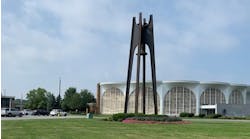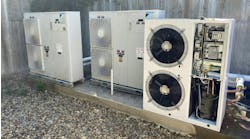There are a lot of folks in Alaska who can thank Kurt Wilken for the warmth and comfort they enjoy each winter when Mother Nature turns her cold shoulder on the Anchorage area. Life gets rigorous when temperatures drop way below zero for weeks at a time and it seems that even the sun is too cold to rise.
But Wilken, who owns Anchoragebased Statewide Mechanical LLC, has been on a mission since 2000, and it’s the deep freeze that drives his unique brand of radiant evangelism.
“I grew tired of hearing about radiant heat as the exclusive source of cold weather comfort for the ‘rich n’ famous’,” Wilken says. “Sure, wealthy people have the ability to fund elaborate, multi-zone radiant heat systems in second and third homes the size of a Wal-Mart store.
“I’ve seen some really fine hydronic work installed in those homes. . . but that still leaves a lot of folks out in the cold,” he adds. “You know, our roads aren’t teeming with Maseratis and Lamborghinis. We see a lot of Fords, Hondas and Chevys around here, and they seem to get the job done pretty well, so why shouldn’t there be an equivalent in the radiant world? We deliver great comfort and efficiency, reliably, at reasonable prices.”
Not sure whether that’s evangelism, or great salesmanship, but he’s got a good point there.
Now, Alaska is gorgeous country. Few people would debate that. But consider this. Driven, enterprising business pros like Kurt Wilken have one key disadvantage (in addition to being way off the main supply route for goods and materials): they’ve got about nine months a year to do what most contractors do in a year’s time. Time is of the essence because, when winter arrives, it slows things to a crawl.
When the weather cooperates, Wilken routinely works 60 to 70 hours a week (on a normal week). And if he’s not working, he’s driving to the jobsite. Just check the stats: his four and a halfyear- old, 3/4-ton, extended cab Dodge pickup truck has 224,000 miles on it.
Alaska is a land of extremes. If the temperatures or the bugs, the bears or its remoteness don’t challenge you, the miles will. Statewide Mechanical’s range of operation spans about 20,000 square miles.
Add to that the reality of a short season.
“In the winter and spring, where there’s work to be done inside, we’re glad to have it,” he says. “But, invariably, we bump into a challenge when some part of the job requires outdoor work. We may need to dig a trench, have access to a pipe underground, or to begin a snowmelt installation. We learn to deal with it.”
Alaska winters begin in September and roll well into April, leaving four months to git ‘er done when it’s warm enough to do the exterior work.
“We’ve hit ice underground while trenching in May and June,” he adds.
Statewide Mechanical currently employs 12 hydronic and radiant heat specialists, and they maintain seven trucks. Their specialties are hydronics, radiant heat and plumbing — and all of their business is in new construction. Wilken chose that path several years ago and he’s sticking to it. The focus of their work: new home installations, typically in the 1,500 to 3,000-sq.ft. range; duplexes; multiplexes; apartment buildings, condos and hotels.
Wilken explains that just two years ago the new construction market in Anchorage was robust. Today, the home market has deflated by around 30%. An interesting twist, however, is that more homebuilders have moved to hydronic heat — radiant heat, baseboard and hydro-air — as a means of enticing buyers, appealing to their desire for higher energy efficiency, system reliability and comfort.
Late last summer, Wilken and one of his crews tackled installations at a 1,447-sq.ft. ranch style home in Wasilla, a suburb of Anchorage. This is a home for a first-time buyer on a limited budget. The installation is the essence of what helps to differentiate Statewide’s offering among his 25 homebuilder customers: offering a plumbing/domestic water and radiant heat package that’s relatively simple, reliable and affordable.
“But there’s no compromise on efficiency, comfort or durability,” says Wilken. “We use only the best and most reliable products on the market; our ‘recipe’ if you will.”
Statewide’s recipe includes:
- Miles of Viega potable water PEX and radiant heat tubing and manifolds. “We keep our radiant loops within 10% length for balance,” he notes.
- A power-vented, direct-fired Bradford White Combi2 water heater to meet domestic water and space heat needs simultaneously. “The new design with its large steel heat exchanger is just what we need.”
- Grundfos pumps. “We buy threespeed UPS 15-58 circulators by the pallet.”
- Beacon Morris fan-powered unit heaters, the preferred method to deliver garage heat.
- Watts Water Technologies feedwater components, backflow prevention devices and relief valves.
“It’s like building a machine that works, over and over again,” he says. “We know exactly how best to build the system, and how it will perform. We have a stable list of system components, and know how each piece goes in, everything about its operation, and how it interacts with all the other pieces.”
This helps them to enhance their offering to prospective homeowners. Statewide’s mechanical package looks simpler when compared to more elaborate hydronic systems with a much higher price point. But the “package” does this in spades: it avails radiant heat and plentiful domestic water heating to many first-time home buyers who would otherwise miss out on the comfort and reliability that wealthier folks have come to take for granted.
The home in Wasilla is tucked in to the suburban development of Center Point, built by Horizons LLC, based in Eagle River, Alaska. Horizons is a moderately sized builder for the region, with a strong emphasis on comfort and quality.
“We wouldn’t recommend installing anything other than radiant heat in one of our homes. It’s our standard; not the upgrade,” say Linda Frank and Mike Parker who own the general contracting firm. “The heating quality, and comfort far exceed any other heating design we’ve experienced. Statewide Mechanical installs many of these systems in single family, duplex and multiplex applications with great success.”
The home at Center Point achieved a Five-Star Energy Rating — this is an Alaska Housing rating which meets the criteria for Federal tax credits (especially important for the builder). It has two radiant zones: one for the master bedroom and guest bedroom, and one for the main common areas. There are also two high-heat zones; one for the garage heater by Beacon Morris, and the other for the power-vent Bradford White “Combi.”
“The system’s first priority is the domestic water heating,” explains Wilkens. “When that need is met, it’s got plenty in reserve for space heating, whether it’s used for radiant or hydroair.”
Wilken points out that the water heater’s large, double-wall, glass-coated steel coil ensures separation of the potable water and heating fluid.
“The biggest plus is the efficiency of its domestic water recovery,” he says. “With the much larger internal coil, head loss is reduced significantly. So now there’s no need for concern when we need to pump out enough heat to satisfy 40 Btu/sq.ft. If we need it, it’s there.”
That capability plays well with another of the water heater’s strengths: the challenge of heating domestic water in Alaska. Groundwater temperatures are typically around 38°F, requiring a lot more Btu to heat the incoming supply. The 72-gal., 76,000 Btuh, gasfired, power vent units handle this well when Wilken sets the aquastat to its highest temperature setting of 180°F.
“With a Grundfos UPS 15-58 pump set on high speed, we usually see a 150°F outgoing temperature and a return temperature of 130°F,” adds Wilken. “And because the Combi2’ s are preheated to 180°F and the packaged tempering valve is being used, you essentially have 130-gal. of water preheated, and ready for domestic use, with a 38°F incoming temperature.”
Wilken revealed another part of the recipe when he mentioned that they use 110V line voltage thermostats to simplify control wiring.
“Each t-stat controls one of two Grundfos wet rotor circulators,” he explains. “The flow check in each pump helps to eliminate natural convection. We also use a spring check valve on the return side of the Combi2’s heat exchanger to completely eliminate the tendency for thermal migration. The circulator’s three-speed capability is also important. We have the flexibility of using any of the settings, and we’ve learned that later changes to the system can usually be met with the simple flick of a switch.”
Transporting the heat at the house is 2,400 lineal feet of 1/2-in. ViegaPEX tubing. Another 1,100-ft. of their Pure- Flow tubing was installed to meet all domestic water needs. And because of the system design temperature — -30°F! — Wilken typically uses 150°F delivery temperatures for the staple-up radiant.
“We use ‘full curl talons’ rather than staples for the under-subfloor, suspended tubing application to eliminate the risk of noisy expansion,” he says. Wilken added that they can meet space heating needs within multiplexes with shared common walls with radiant heat outputs of 20-25 Btu/sq.ft. And, for the free-standing single family homes, they occasionally need to go as high as 40 Btu/sq.ft.
“Along exterior walls, we routinely go to 4-in. centers when attaching radiant loops to the subfloor,” he says. “The way that’s done within a 16-in. joist bay is to pull a complete run through and into the joist bay and then to run another loop within it ... the first loop goes to the outer position within the joist bay, and then the second pull goes within that one to get 4-in. centers.
For insulation, they usually see R-19 in the walls and R-42 or R-60 in ceilings. Below their staple-up work, R-13 with a 2-in. or 3-in. air gap just under the subfloor is most common.
Another interesting piece of this mechanical puzzle is one that pertains to any system installed in Alaska. Few people realize that Alaska is one of the most seismically-active regions in the world. As a precaution, the state has mandated seismic strapping for all water heaters.
For Statewide, it’s a recipe that works. So well, in fact, that they have many more jobs on the charts, all with the same set of components:
- Four-plex staple-ups with hydronic unit heaters in each garage for Horizons LLC.
- A 70-unit duplex project with Hearthstone, Signum Design Build.
- A 96-unit duplex/triplex project called Dove Tree for Discovery Construction Inc.
- A 42-unit multi-family project of six- and seven-plexes dubbed Chugach Meadows for Discovery Construction.
- A 20-unit duplex project, with staple-up and hydronic unit heaters in garages known as the Avalon Subdivision.
They’ll do 200 to 250 water heaterbased systems within the next 10 months. By next July, he anticipates several new subdivisions and multiplexes, all in the early planning stages now. Though the construction boom may be down in Anchorage, this firm’s found a recipe for success.

